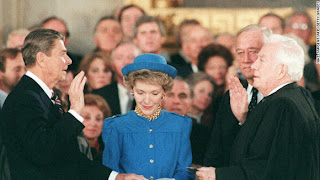http://www.chicagotribune.com/news/opinion/ct-oped-0401-reagan-20130401,0,3481356.story
http://eedition.chicagotribune.com/Olive/ODE/ChicagoTribune/LandingPage/LandingPage.aspx?href=Q1RDLzIwMTMvMDQvMDE.&pageno=MTU.&entity=QXIwMTUwMQ..&view=ZW50aXR5
chicagotribune.com
By Mary Claire Kendall
April 1, 2013
 |
| President Reagan is publicly sworn in for his second presidential term by Supreme Court Justice Warren Burger on January 21, 1985. Since January 20 was a Sunday that year, the official swearing in of Ronald Reagan took place privately in the White House. (Mike Sargent/AFP/Getty Images/January 21, 2013) Here's a portion of President Reagan's speech that historic day. |
The city of Chicago has given the go-ahead to Heneghan Wrecking and Excavating Co. to demolish, on behalf of the University of Chicago and its medical center, President Ronald Reagan's boyhood home on the South Side at 832 E. 57th St.
He lived there the year
of the Eastland disaster. Occurring July 24, 1915, it was Chicago's most lethal
calamity — deadlier than the Great Chicago Fire of 1871 — killing some 844
people.
Word has it that Reagan
reminisced about this steamship catastrophe on the Chicago River as a vivid
early memory, recounting how he was left home when his father took his older
brother "Moon" across town to see it.
While a source recently
declined to "confirm or deny" this reminiscence, one thing's certain:
Ronald Reagan, at age 4, lived in Chicago the day of the Eastland disaster. And
it's good bet he didn't witness it since, if he had, that memory would surely
have figured into his writings and speeches. Little Ronald "Dutch"
Reagan must have resolved then to never again to be far from the scene of the
action.
Right now, the action is
at the home where Reagan once lived. It's all that's left of the entire block
between Maryland and Drexel avenues on East 57th Street. The rest of the block
was demolished in early January to make way for a hospital and research
facility, across the street from the recently inaugurated University of Chicago
Medicine's new Center for Care and Discovery. In the ultimate irony of history,
these facilities will feature state-of-the-art Alzheimer's research.
That the Reagan home is
still standing is a bit of a miracle. We all know the "Chicago Way."
The Friends of President
Reagan's Chicago Home has worked doggedly to save it, agreeing with the
Commission of Chicago Landmarks in 1986 that it is "noteworthy due to
historical associations," which gives it "landmark potential."
While the current crop
of Chicago bureaucrats couldn't find it in their hearts to landmark the home,
make no mistake, this home where Reagan lived is a landmark, which completes
the Ronald Reagan Trail in Illinois, including the landmarked Ronald Reagan
Boyhood Home in Dixon (1920-23).
Later, Reagan had
long-distance ties to Chicago. He broadcast Cubs games for WHO-AM in Des Moines
and courted and married Nancy Davis, who hailed from the Near North Side.
One of Reagan's biggest
successes as president was the 1986 tax bill, a product of an after-hours
friendship with Chicago's principal ambassador to Washington, House Ways and
Means Chairman Dan Rostenkowski. They knew each other as fellow Chicagoans.
All of that was
inconceivable when little "Dutch" looked out his window on East 57th,
after surviving near-fatal pneumonia, longing to be at the center of the
action.
If we demolish the
physical context of his formative years, we extinguish an essential part of
Reagan's story — a youngster who despite being the child of an itinerant,
alcoholic, frequently unemployed shoe salesman, grew up to become the global
symbol of freedom from tyranny and triumph over communism.
President Barack Obama,
the second U.S. commander in chief with a home on Chicago's South Side, is
likely justly proud of the improbability of his own story.
The two homes, blocks
apart on different sides of the University of Chicago — one a spacious Kenwood
home, the other a humble Irish working-class flat near Washington Park — work
together to tell all Americans who we are now — and who any one of us might
become.
It's the story of
America. Reagan's boyhood home is worth preserving.
Mary Claire Kendall is
president of the Friends of President Reagan's Chicago Home.
Copyright © 2013 Chicago Tribune Company, LLC
No comments:
Post a Comment